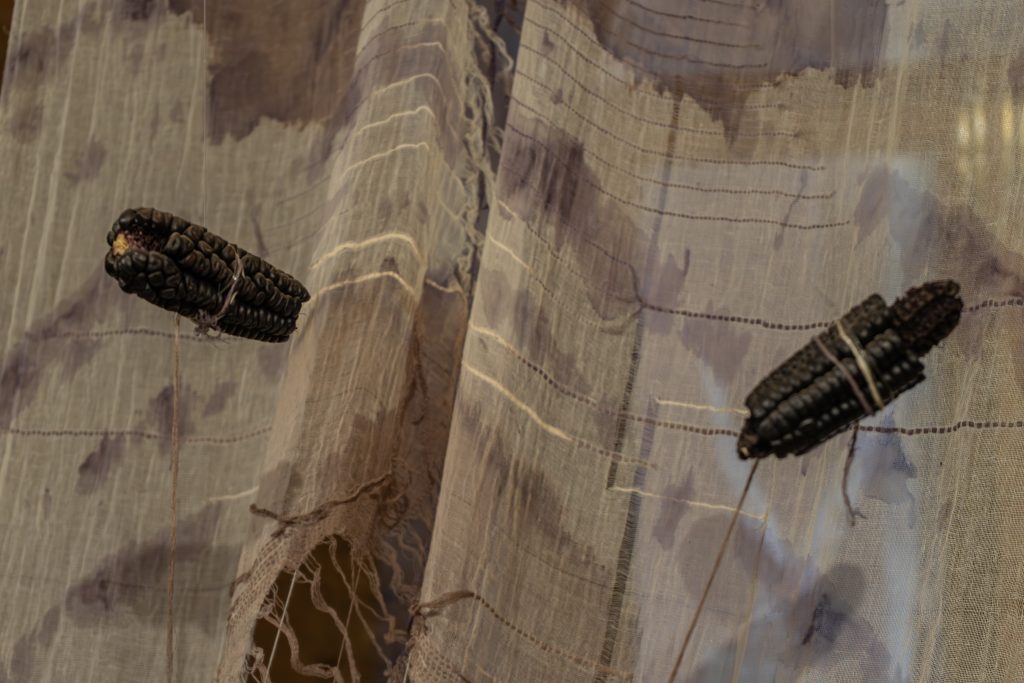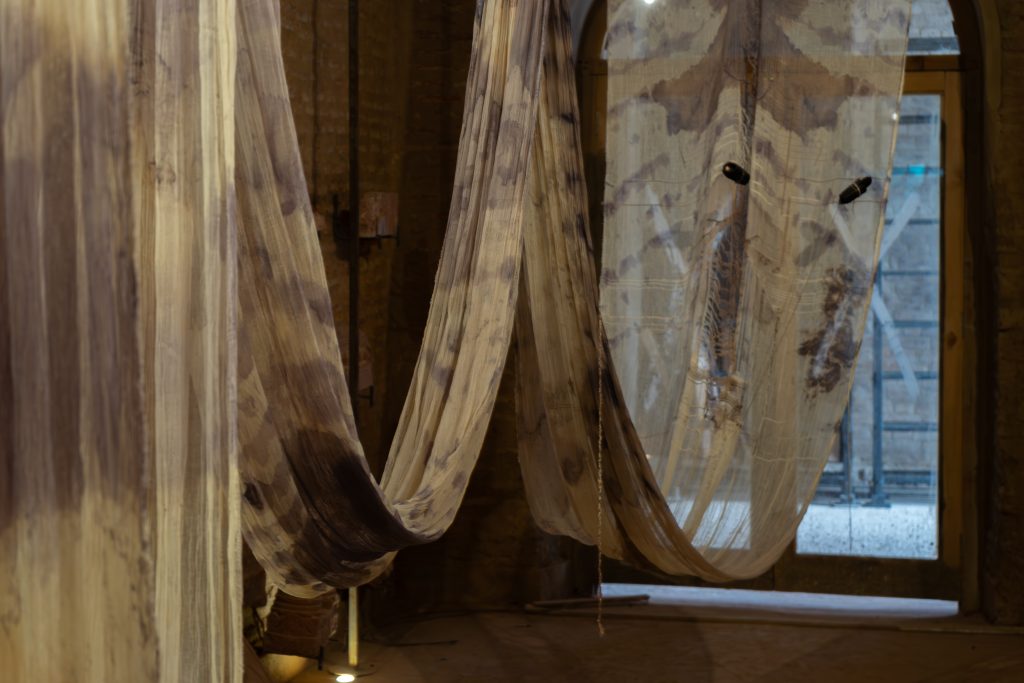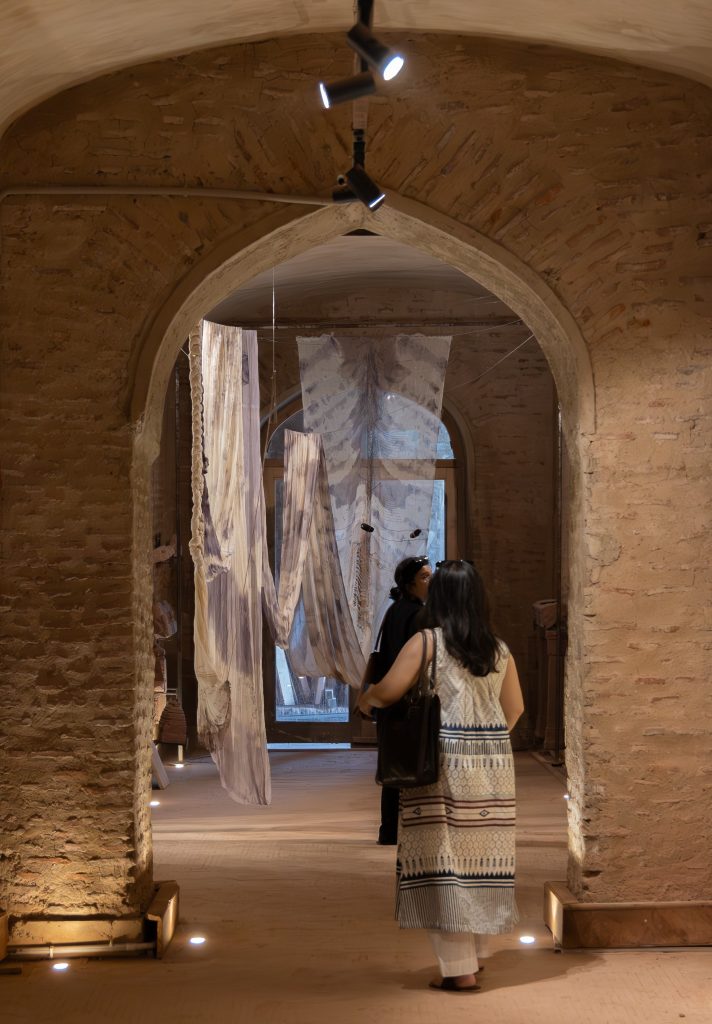Cristina Flores Pescorán
Mesa Ritual. Chola Body Story, 2022-23
Textile installation with needles and purple corn
An extended fabric installation, Mesa Ritual Chola Body Story, is based on the artist’s own medical experiences. Taking as its point of departure the medical gauze that was ever-present during the artist’s experience with chemotherapy, the artist employs a reticular weaving technique similar to the openwork of indigenous gauzes, which the pre-Incan Chancay society believed to have healing and protection powers, to rewrite her own experiences of skin cancer, a condition that spanned almost half her life. By pulling out existing threads and inserting new lines and knots, the artist embeds new patches of energy fields into the internal body of the textile. Flores Pescorán further dyes the fibers with maiz morado, the purple corn indigenous to the Andes, and which she consumes for its restorative properties, and also as a reminder of home. By bringing together pre-Hispanic weaving and dyeing, indigenous knowledge of plants, and shamanic healing, Flores Pescorán’s ritual altar (mesa ritual) invites us to reflect and rethink what we understand by medicine, illness, death and regeneration from a feminist and decolonial, yet deeply personal, perspective.
Cristina Flores Pescorán is an artist (b. 1986) whose installations, performances, and videos weave together her bodily experiences of cancer and recovery with explorations of the precolonial textiles and medicinal plants of her native Peru, engaging in a feminist dialogue with healing processes, family memories, and precolonial heritage. Her work has recently been shown as part of the Biennale of Sydney and the Toronto Biennial of Art.
کرسٹینا فلوریز پسکوران
میسا رچوئل۔ چولا باڈی اسٹوری، 23-2022
سوئیوں اور جامنی مکئی پر مشتمل کپڑے کی تنصیب
کرسٹینا فلوریز پسکوران (پیدائش 1986) ایک فنکارہ ہیں جن کی تنصیبات، پرفارمنس، اور ویڈیوز کینسر اور صحت یابی کے جسمانی تجربات کو اپنے آبائی ملک پیرو کے قبل از نوآبادیاتی کپڑوں اور طبی پودوں کے ساتھ ملا کر پیش کرتی ہیں۔ وہ شفا یابی کے عمل، خاندانی یادوں، اور قبل از نوآبادیاتی ورثے کے ساتھ ایک نسوانی مکالمے میں مشغول ہوتی ہیں۔ حال ہی میں ان کے کام کو سڈنی بینالے اور ٹورنٹو بینالے آف آرٹ میں پیش کیا گیا ہے۔
میسا رچوئل۔ چولا باڈی اسٹوری ایک وسیع کپڑے کی تنصیب ہے جو فنکارہ کے اپنے طبی تجربات پر مبنی ہے۔ یہ کام اس طبی گاز سے متاثر ہے جو فنکارہ کے کیموتھراپی کے دوران ہر وقت موجود رہتا تھا۔ اس تنصیب میں فنکارہ نے ایک جالی دار بُننے کی تکنیک کا استعمال کیا ہے جو قبل از انکائی چانکائی معاشرے کے مقامی گازوں کی کھلی بُنائی سے مشابہت رکھتا ہے، جن کے بارے میں خیال کیا جاتا تھا کہ وہ شفا اور تحفظ کی طاقتیں رکھتے ہیں۔ اس کے ذریعے، فنکارہ نے اپنی جلد کے کینسر کے تجربات کو دوبارہ لکھا ہے، ایک حالت جو ان کی زندگی کے تقریباً نصف حصے پر محیط رہا۔ وہ موجودہ دھاگوں کو کھینچ کر اور نئے دھاگے اور گانٹھیں ڈال کر، کپڑے کے اندرونی جسم میں نئے توانائی کے میدانوں کے پیچ ڈالتی ہیں۔ پھر وہ اس کپڑے کو ماز مورادو یعنی اینڈیز کی جامنی مکئی سے رنگتی ہیں، جسے وہ نہ صرف اپنی صحت یابی کے لیے استعمال کرتی ہیں بلکہ اپنے وطن کی یاد کے طور پر بھی۔ قبل از ہسپانوی بُنائی اور رنگائی، مقامی پودوں کے علم، اور شمانی شفا یابی کو یکجا کرکے، فلوریز پسکوران کی یہ رسوماتی قربان گاہ (میسا رچوال) ہمیں دوا، بیماری، موت اور احیا کے تصورات پر نسوانی اور نوآبادیاتی نقطہ نظر سے، لیکن ایک ذاتی انداز میں غور کرنے کی دعوت دیتی ہے۔




